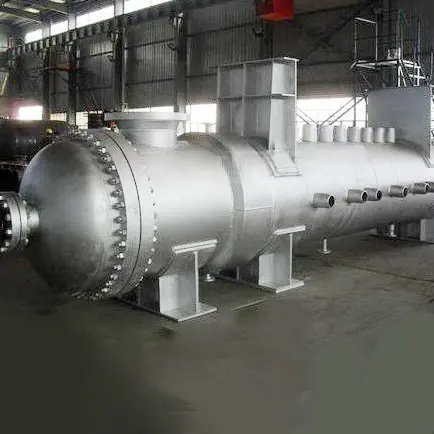When designing, put steam on the side of tube so as to prevent high-speed gas passing through the shell side. Also, multiple entries of shell side can be designed to buffer the pressure if the flow of media is relatively high. In addition, an impingement plate should be set to reduce the erosion and corrosion of equipment caused by high-speed fluids.
In order to avoid residual liquid and the retention of sediment, adopt double-side butt welding and continuous welding rather than lap welding and spot welding. Because according to practical experience, residual stress, which is mostly generated by cold working and welding, is what mainly causes stress corrosion cracking.
Heat treatment of cold-worked and welded parts can help to eliminate residual stress and thereby prevent stress corrosion. Common annealing treatments or other methods for eliminating residual stress include hydrostatic test, vibratory stress relief, hammering, etc. Besides, the tube bundle must be hoisted with a nylon belt to ensure that the metal surface is flat, without scratches, and can be smoothly put into the shell.
Corrosion-resistant Materials
Corrosion-resistant materials such as Hastelloy, titanium, titanium alloy, copper have strong corrosion resistance and can prolong the service life of heat exchangers. But the problem is that the price as well as manufacturing cost of these materials are really high.
Electrochemical Protective Measures
Not only can electrochemical protective measures (including cathodic protection, anodic protection and coating corrosion-resisting metal on surface) prevent stress corrosion cracking, such measures can also stop the expanding of cracks.
Cathodic Protection:
By using an external DC power, the protective method turns the anode on the surface into cathode. But this method is seldom adopted since it is expensive, and will consume a lot of power.
Anodic Protection:
The protected equipment is connected to the anode of the power supply so as to form a passive film on the metal surface. The cost of carbon steel heat exchangers is low, but they are with poor corrosion resistance. The service life of heat exchangers can be improved by using anodic protection method, but this technique is limited to a finite length of the entrance of the tube.
Adding Corrosion Inhibitor
In corrosive media, adding a small amount of certain substances on the principle of no affecting production processes and the quality of product can greatly reduce the corrosion degree of metal, or even fully prevent corrosion. Stress corrosion can be controlled by removing dissolved oxygen and oxidant from the media. Decreasing and strictly controlling the density of chloride ion and sulfur in the media is another effective measure to prevent stress corrosion.
Anti-Corrosion Coating
Coating a corrosion-resistant protection layer on the surface of metal can prevent direct contact between the metal surface and corrosive media. This is the most cost-effective measure which is initially used for preventing corrosion of gaseous media. Most of the coating materials are organic polymer solutions.
Heat Exchanger Operation
When heat exchangers are operating, fill the container with low-temperature fluid, close the entry and then slowly inject high-temperature fluid, this is for minimizing the thermal expansion difference between the tube and the shell.
After turning off, use dry compressed air to remove all the fluids in the heat exchangers in order to minimize the pressure and avoid stress corrosion. During the operation process, the upper and lower water valves should be fully open so as to prevent the speed of flow decreasing and corrosion that causes by residual impurities.


 English
English Español
Español русский
русский